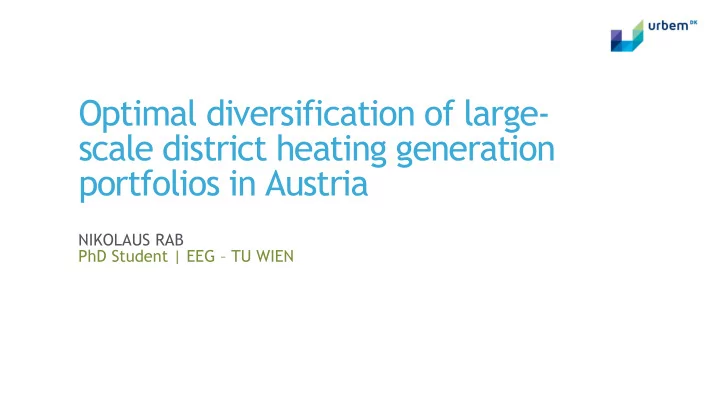

Optimal diversification of large- scale district heating generation portfolios in Austria NIKOLAUS RAB PhD Student | EEG – TU WIEN
Motivation In Austria 28% of its citizens are supplied by DH, but economic viability has been challenged in the past years as natural gas power plants turned unprofitable. In 2010 61% of the DH demand in Vienna was supplied from waste heat from natural gas power plants. Diversification of heat sources and fuels for District Heating (DH) is fundamental for enabling long-term stable and competitive prices. Uncertainty of fuel prices can be identified as the key cause of DH plant investment risk . TARGET : Optimal Transformation of existing DH generation portfolios towards portfolios with competitive and low-volatile generation costs . Share of DH generation in total heat generation per EU member country 2
Why is Diversification Fundamental? “ Uncertainties in fuel costs […] could lead to heat technologies going from being cost effective to being less attractive technology choices.” [1] [1] Modassar Chaudry, Muditha Abeysekera, Seyed Hamid Reza Hosseini, Nick Jenkins, Jianzhong Wu, Uncertainties in decarbonising heat in the UK, Energy Policy, Volume 87, December 2015, Pages 623-640 Average costs of DH generation of the past 12 months with a utilization of 5.000 full load hours . 3
Methodology • The generation portfolio selection is based on minimizing expected LCOH adjusted by some level of risk , defined as variance ( Risk-Averse Two-Stage Stochastic Programming ). • More precisely the DH operator's utility from an uncertain pay-off P is given as: where beta is a parameter reflecting the risk aversion . • Fuel costs are modelled as stochastic processes (multivariate Geometric Brownian Motion). • DH demand and merit orders vary strongly over time , which is explicitly accounted for in the approach. 4
Case study Mean-variance optimal generation portfolios in 2030 for the three largest DH systems in Austria : Vienna, Linz and Graz based on the existing generation park in 2015. Energy Price Data (Electricity and EUA: EXAA spot, natural gas: EIPI, wood chips: Wiener Warenbörse): Transmission/transportation costs and taxes: as of 2015. • Volatility and correlations: historic values (2002-2015). • Expected value: Energieszenarien 2050 (WIFO). • Share in annual DH generation in Austria. 5
Vienna: Installed capacities Distribution of generation costs 6
Vienna: Expected annual generation Distribution of generation costs 7
Linz: Installed capacities Distribution of generation costs 8
Linz: Expected annual generation Distribution of generation costs 9
Graz: Installed capacities Distribution of generation costs 10
Graz: Expected annual generation Distribution of generation costs 11
The role of heat pumps When minimizing expected generation costs is the only target, heat pumps are • typically not part of the least-cost portfolios for 2030 in Austria. However least-cost portfolios are very vulnerable to unfavourable price developments , i.e. economic not viable in these scenarios. • Heat pumps are used for diversification purpose in mean-variation optimal generation portfolios, in particular when gas CHP plants are present. Compared to least-cost portfolios, expected generation costs are slightly higher, but their volatility is much lower . 12
NIKOLAUS RAB PhD Student | EEG – TU WIEN nikolaus.rab@tuwien.ac.at
Methodology (backup) 14
Recommend
More recommend